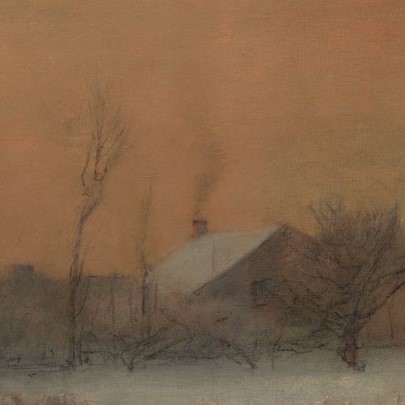Asher Durand’s Progress Reconsidered
In 2011, Asher Durand’s Progress (The Advance of Civilization) disappeared from the walls of the Westervelt-Warner Museum of American Art in Tuscaloosa, Alabama. That corporate museum held the collection assembled by Jack Warner, the longtime president and CEO of Gulf States Paper Corporation, renamed the Westervelt Company in 2006, following his retirement (fig. 1). The Westervelt Company owners disposed of the painting in a private sale for a sum said to be in the vicinity of $40 million. The identity of its purchaser was not revealed.
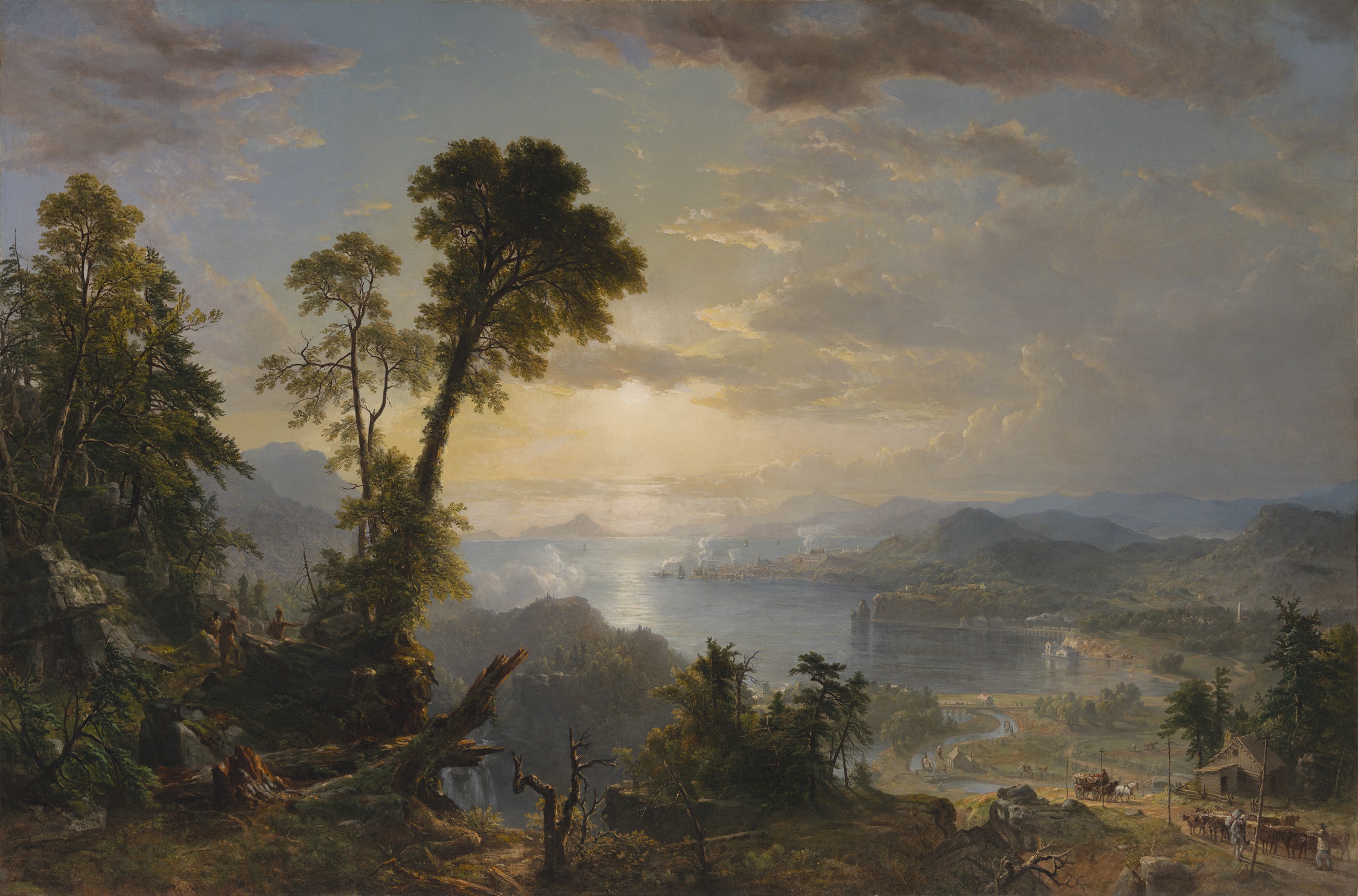
As years passed without a sign of the painting, some of us began to fear that we would not see it again. Yet, when the spectacular exhibition Thomas Cole’s Journey: Atlantic Crossings, curated by Elizabeth Mankin Kornhauser and Tim Barringer, opened at The Metropolitan Museum of Art in January 2018, there it was hanging in the final gallery, courtesy of an anonymous lender. A lively discussion of the painting at the Thomas Cole Scholars’ Day, held in conjunction with the exhibition, stimulated the thoughts that I offer in this essay. The year 2018 closed with more welcome news: in December, the painting’s owner generously donated it to the Virginia Museum of Fine Arts in Richmond. For the first time since Durand completed Progress in 1853, it was securely in the public domain, no longer subject to ready sale.1
Even before these dramatic events, Progress had achieved the status of a canonical work, reproduced in a multitude of publications, including major survey texts.2 Consistently it is presented as a jingoistic counterpoint to Thomas Cole’s Course of Empire series (1833–36; New-York Historical Society), with Cole’s dire warning about the consequences of imperial conquest and unbridled industrial development contrasted with Durand’s supposedly unqualified endorsement of the same. This view is succinctly expressed in Kindred Spirits: Asher Durand and the American Landscape, the catalogue of the major Durand exhibition held at the Brooklyn Museum in 2007: “Progress may be interpreted as a midcentury meditation on (and revision of) Cole’s The Course of Empire. Cole’s political pessimism is replaced by an optimistic message in Durand’s panoramic vision of what might be termed . . . the landscape of investment.”3 Critic Grace Glueck, in her New York Times review of the exhibition, echoed this judgment, describing Progress as an “uncharacteristically bold endorsement of the Manifest Destiny belief in United States expansion to the Pacific,” one that “gives a reverse twist to Cole’s pessimistic painting The Course of Empire.”4 In contrast, I wish to suggest that beneath the painting’s veneer of approbation runs an undercurrent of regret and even hostility toward “progress”.
The first thing to note about Progress is that its theme of technological advancement is unusual, indeed unique, among Durand’s paintings. A road opens in the far right corner of the expansive landscape, drawing us downward into its pictorial depths, guiding us not just physically but also temporally toward an increasingly urbanized and technologically sophisticated future. A line of telegraph poles lead past a log cabin, then a canal evocative of the Erie Canal, which opened in 1825, with an official invitation engraved by Durand himself.5 Farther in, a train traverses a viaduct. In the distance, clouds part and light floods onto a busy port city where smoke plumes rise from churning steamboats and factory chimneys vie with church steeples for prominence (fig. 2).
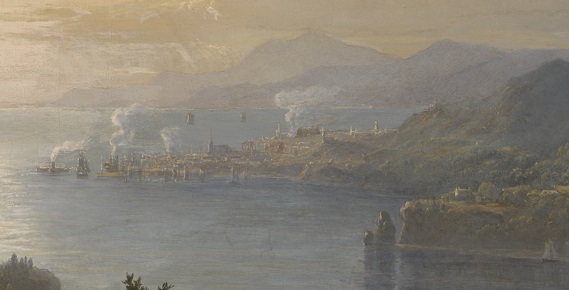
Among the hundreds of works included in David Lawall’s invaluable reference, Asher B. Durand: A Documentary Catalogue of the Narrative and Landscape Paintings, no other painting includes a train, a canal, or a telegraph pole. One work, from the beginning of Durand’s career as a landscape painter, offers a distant view of a city: New York City from Hoboken Heights of about 1835 (current whereabouts unknown).6 One from the end of his career, painted when he was seventy-nine years old, incorporates a steamship: Black Mountain from the Harbor Islands, Lake George (1875; New-York Historical Society), in which a pleasure steamer, barely visible, plies the distant reaches of the lake. Both take the quiet delights of sojourns away from the city as their theme.
Apart from Progress, these are the only allusions to urban development and technological advancement in all of Durand’s painted oeuvre. The vast majority of his landscapes are nostalgic, retrospective pictures that carry us into wooded glades and serene pastoral scenery. Indeed, the artist generally regarded his landscapes as antidotes to the abrasions of urban and commercial life, an ambition with which Progress hardly accords, drawing us as it does from the wilderness into the city.7
Durand’s personal attitude toward the mid-nineteenth-century cult of progress was not that of an enthusiastic booster. While he took advantage of trains and steamboats on his travels, designed banknotes that fed the culture of commerce, engraved the invitation to the official opening of the Erie Canal, and even invested in railroads (purchasing $2,000 worth of bonds in the Buffalo and New York City Railroad Company in 1856, three years after he completed Progress), his affection was always for the pre-industrial landscape.8 He passed his childhood rambling through the countryside near the family farm in rural New Jersey, a spot that he always recalled with great fondness and to which he returned in his retirement. Throughout the long intervening years, from 1817 to 1869, he lived in New York City, which he described in a letter from the 1830s to his good friend Thomas Cole as a “miserable little pen, enclosing 250,000 human animals or more.” In Cole’s reply, he attributed Durand’s depressed spirits to his urban environment, writing, “You sit (I know you do) in a close, air-tight room, toiling, stagnating, and breeding dissatisfaction at all you do, when if you had the untainted air to breathe, your body would be invigorated, your spirits buoyant, and your pictures would even charm yourself.” Durand, in his turn, lamented the “circumstances” (his work as a portrait painter) that then kept him in the city. If it were not for that, he told Cole, “the vast range of this beautiful creation would be my dwelling place.”9
Later, in 1849, when Durand had fully turned his attention from portraiture to landscape, he purchased a home on the Hudson River near Newburgh, New York. His son John described it as “a house situated on an elevation overlooking the ‘Vale of Avoca,’ through which ran a somewhat picturesque stream.” Yet, as John reports, the land was “soon wanted for a railroad; the ground was turned up; fever-and-ague made its appearance, [and] drove him from his country retreat.”10 A decade earlier, in 1836, Cole had raged against the axing of trees near his Catskill home to make way for a railroad, writing to his and Durand’s most important patron, Luman Reed: “Tell this to Durand [,] not that I wish to give him pain, but that I want him to join me in maledictions on all dollar-godded utilitarians.”11 With the loss of his own country home, Durand personally felt the upheavals and destruction attendant on progress.
Yet as irked and at times depressed as Durand was by the need to live in New York, the city provided him with many of his best patrons as well as a motive, a mission for his landscapes. He was convinced that his paintings could be of particular benefit to its commercial men, easing the psychic insults and deprivations of urban life. In his famous “Letters on Landscape Painting,” he wrote that “the rich merchant and capitalist,” having completed “his daily drudgery,” could sink into “his favorite armchair, with one or two faithful landscapes before him, and making no greater effort than to look into the picture instead of on it,” find that “pleasant reminiscences and grateful emotions will spring up at every step, and care and anxiety will retire far behind him.” Particularly for those who traced “their first enjoyment of existence . . . to the country,” as he had, a “true” landscape painting “becomes companionable, holding silent converse with the feelings . . . and, at times, touching a chord that vibrates to the inmost recesses of the heart.”12 To Durand, nature and its faithful representations were healing, restorative, and spiritually uplifting.
Landscape and the spiritual were always intertwined for Durand. He believed that a great artist gives expression to “the spiritual beauty with which nature is animate.”13 The landscape painter’s essential role, he wrote, is to faithfully and reverently record the “work of God in the visible creation,”14 adding that a landscape “will be great in proportion as it declares the glory of God, by representation of his works, and not of the works of man.”15
Why, then, would Durand, who believed so strongly that the role of landscape was to turn viewers’ thoughts from human activities to the work of God, take on a subject such as Progress? The most likely answer is that it was chosen by a patron. This is the case with the other painting by Durand that departs in obvious ways from his usual mode: his one excursion into the horrific sublime, God’s Judgment Upon Gog (c. 1851–52; Chrysler Museum of Art). The New York businessman Jonathan Sturges, an active and sympathetic supporter of the city’s landscape artists, commissioned the painting and requested its subject. It was exhibited at the National Academy of Design annual exhibition in 1852, the year before Progress appeared there. Progress, too, was commissioned, ordered by another New Yorker, the stockbroker and later railroad and mining executive Charles L. Gould (1811–1870). No correspondence initiating the commission survives, so it is not known when exactly Gould ordered the painting nor to what extent he directed its content, yet it seems more than likely that its subject originated with him, an investor with a keen interest in railroad stock.
The surviving correspondence about the commission between Durand and Gould suggests a tense relationship. Soon after placing the final touches on the canvas, Durand submitted it to the National Academy of Design’s annual exhibition without letting Gould know of its completion and without inviting Gould to the exhibition’s opening. Gould learned of the painting’s completion from John Kensett, who had recently sold the broker a landscape that was on view in the same exhibition.16 Gould wrote to Durand of the omitted invitation, “I . . . said to Mrs. Gould that I presumed a card was addressed to me and not duly delivered.” Durand had written to Gould earlier complaining of the “chilling” tone in Gould’s correspondence with him, which Gould emphatically denied, asserting that he was attempting only to be “courteous.”17
Curious about what might account for the cool, abrasive tone of these notes, especially given Durand’s usually cordial demeanor, I looked further into Gould. A passage in an 1868 letter from Martin Johnson Heade to Frederic E. Church deepens questions about Gould’s character: “It may delight you to know that your friend Mr. Chas. Gould has been black-balled at the ‘Union League Club.’” Heade reports that he was elected to the club himself, but unfortunately leaves unstated his and Church’s reasons for taking such pleasure in Gould’s humiliation.18
While secondary sources offer little about Gould beyond his birth and death dates, nineteenth-century newspapers and court records yield a picture of him that is far from flattering. From the 1840s onward, Gould, who moved to the city from Connecticut, seems to have been intent on establishing himself in the upper ranks of New York society. He purchased a home on Madison Square, drove a team of matched horses, joined elite clubs, and beginning in the early 1850s, indulged in art patronage, purchasing works of art from some of the leading artists of the city, including Durand, who as president of the National Academy of Design since 1846 occupied the summit of the New York art world.19 This all required money, and Gould’s ways of obtaining it were not always aboveboard.
It seems that he was a litigious and unscrupulous businessman. In 1847, the Baltimore Sun reported that Gould had filed a court complaint against the officers and managers of the Philadelphia and Reading Railroad Company, accusing them of sweeping malpractice that had rendered the company “hopelessly insolvent.” The reporter adds, “friends of the company assert that the proceeding has been instituted with an intent to depress the value of the stock for purposes of speculation.”20 Another account underscores Gould’s intemperate character. In 1860, he and Allen Sherman, both recent directors of the Cumberland Coal and Iron Company, lodged complaints against each other for perjury and malicious prosecution, which, in the court’s judgment, arose from a “bitter controversy” between the men, the charges “probably induced quite as much by personal animosity as by any regard for public justice.”21
More damning, in 1862, a judge found Gould guilty of defrauding his own sister of funds that she had entrusted to him for investment.22 Two years after this, an incendiary letter to the editor of the Daily Constitutional Union (Washington, DC) accused Gould of orchestrating a “corrupt stock jobbing scheme,” taking advantage of the current war to persuade Congress to grant him, “under the pretense of ‘military necessity,’” a charter for a railroad from Washington, DC, to New York. The writer finds “ridiculous” the notion that Gould has advanced this project for “patriotic motives,” asserting “no consideration but money moves him to action.”23 Similar allegations of corrupt self-dealing continued until Gould’s early death from apoplexy in 1870, at the age of fifty-nine.24
Most of these published accounts of Gould’s financial scheming appeared after the commissioning of Progress. Whether Durand had heard of the broker’s questionable ethics when he accepted the order or came to know of them later—or at all—is unknown. If he had, it would help to explain the uncharacteristic rudeness of Durand in neglecting to alert Gould to the completion of the painting or invite him to the exhibition at which it was first shown. It may also have contributed to the ambivalence toward “progress” that courses through the painting.
Certainly Durand intended more than a simple celebration of national “improvement.” His choice of composition, as well as his treatment of trees, of entrances and viewpoints, and of figures all tug against that theme. Progress’s composition, dramatically bisected on the diagonal with wilderness on the left and settled land on the right, immediately calls to mind another painting that addresses the development of the American land: Thomas Cole’s View from Mount Holyoke, Northampton, Massachusetts, after a Thunderstorm—The Oxbow, 1836 (fig. 3). Durand knew Cole’s painting well, and the reference, I believe, is deliberate.25 Not only does Durand repeat Cole’s overall composition, but the looping bend of his canal echoes Cole’s oxbow. Durand surely remembered that while Cole was working on The Oxbow, the two artists were commiserating about the destruction of trees to make way for a railroad.
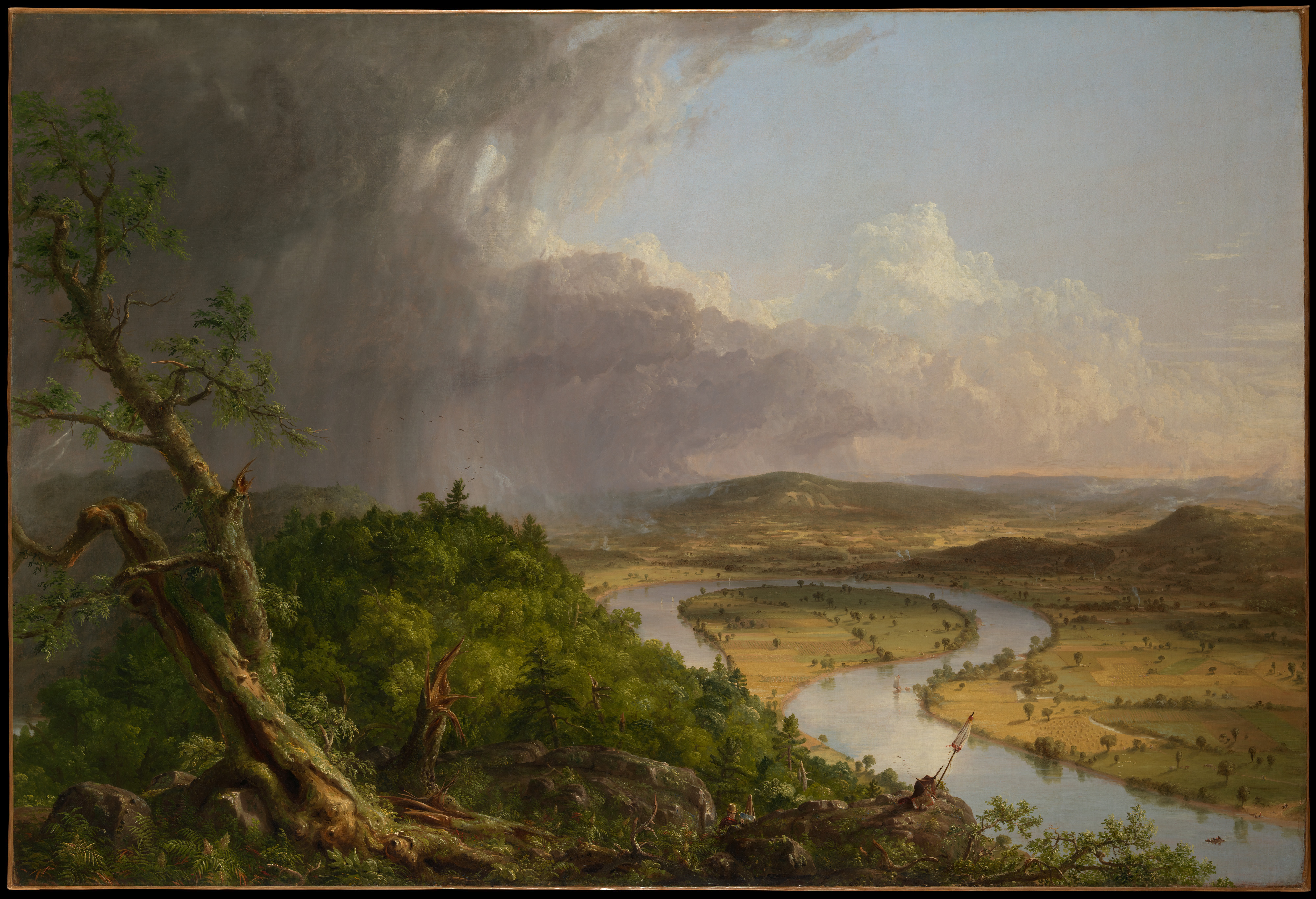
Cole’s painting addresses Americans’ transformation of the land, situating the viewer on a wild, wooded precipice, gazing down onto a flood plain that has been divided into neat, productive fields. Beyond the farmlands, improvers have extended the clear-cutting of forests across the valley bottom and up the nearby hills, as Elizabeth Kornhauser has recently shown.26 So important and personal was this subject to Cole that he included his self-portrait. He is seated in the foreground, his figure nearly lost among the rocky outcroppings and old-growth trees, turning from his easel to address the viewer as though posing a question: “What do you think of this? What will be our future if we continue on this course? What will be the fate of our wilderness?” One way to understand Progress with its obvious echoing of Cole’s composition is as a response to these questions.
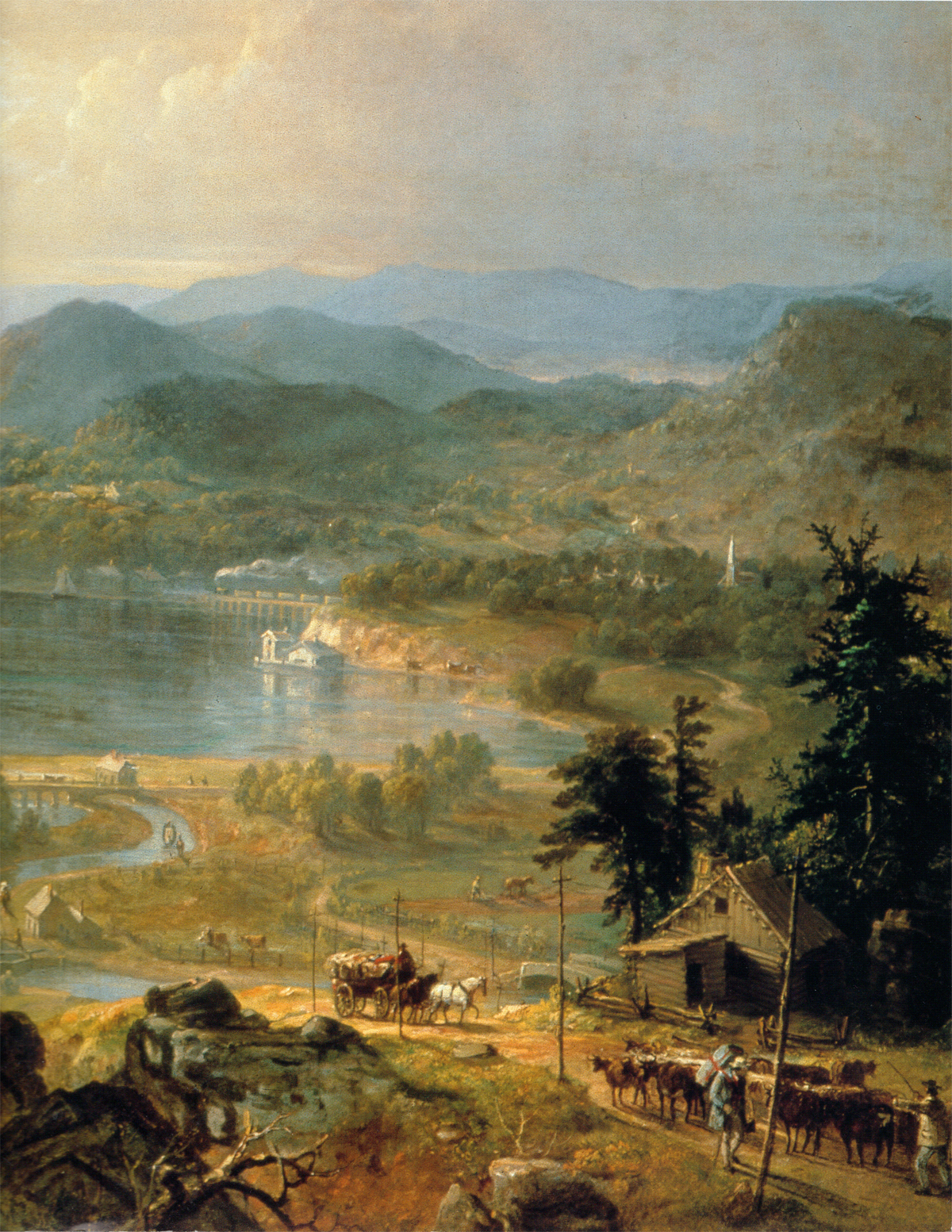
Durand’s answer offers homage to American ingenuity, including his friend Samuel Morse’s invention of the telegraph; yet regret suffuses the scene—with perhaps a note of disgust as well. The fate of trees along the path of progress measures the loss against the gain. Trees, as Roberta Olson has written, were Durand’s “magnificent obsession”; he valued them “above all other aspects of nature.”27 His son John recalled that when the artist felt despondent, he would hoist a pack and set off for the woods “to console himself . . . for all kinds of trouble by studying and painting trees.”28
In Progress, Durand established the theme of the forest yielding to civilization’s advance at the opening of the road, where a few hoary evergreens tower over a log cabin (fig. 4). Their dark green, vigorous, upward-striving forms align with the church steeple just above them, as well as with the cross-shaped telegraph poles below with, their subtle summoning of the Christian theme of sacrifice (Durand deliberately chose this cross form rather than T-shaped or simple straight poles that were common at the time). These trees are all that remain of the dense woods that once covered the hillside. The rest have been uprooted to make way for husbandry or felled to construct the houses, split rail fences, and telegraph poles, whose spindly crosses mark the path of arboreal destruction. At the end of the road, in the distant city, not a tree is visible (see fig. 2). What would this have meant to a man such as Durand, who found his greatest solace in the contemplation and painting of trees, a man who believed that the most appropriate place to worship God was in the midst of nature, who painted woodland groves as sylvan temples?29
Durand underscored his ambivalence toward development by introducing multiple entry points into the composition. In Progress, as in many of his landscapes, he presents the viewer with a choice of paths. One leads along the road of progress; it is obvious and sunlit, but it opens so close to the right edge of the canvas that it is barely included in the frame. Another opens at the viewer’s feet—rutted, less traveled, easily overlooked. It leads over rocks and fallen limbs to a precipice where a small party of Native Americans gaze out on the scene. To take this path is to join them and share their perspective. Through this passage, as Angela Miller has argued, Durand “qualified the meaning of progress by conveying a sense of longing for the ostensibly timeless and unchanging existence of nature’s indigenous inhabitants.”30
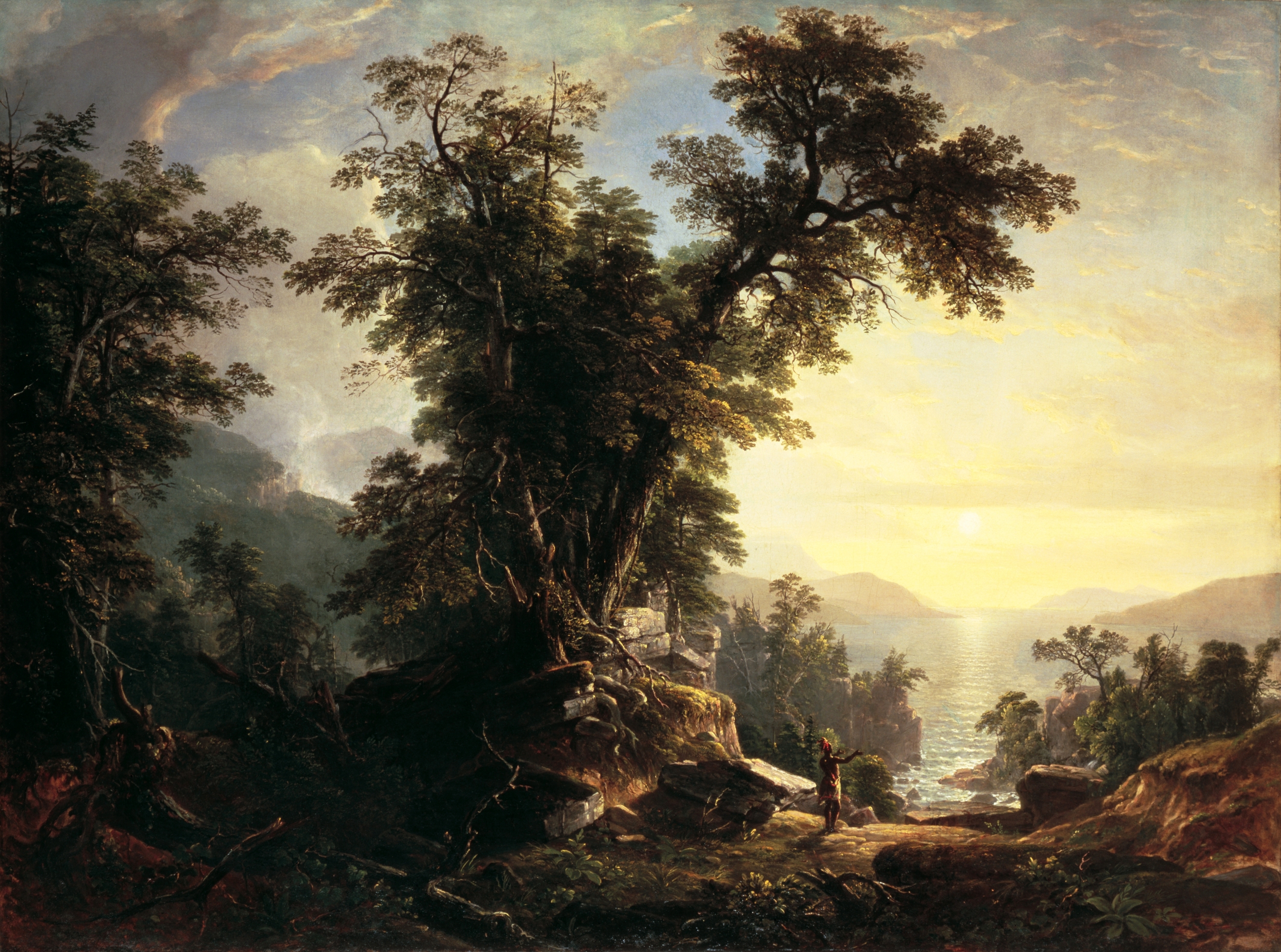
In 1847, six years before completing Progress, Durand painted The Indian Vespers (fig. 5), an image of a Native American standing at the edge of a forest looking across an expanse of water shimmering with sunset light—a scene paralleling the wilderness foreground of Progress. He exhibited it with a couplet drawn from Alexander Pope’s Essay on Man: “Lo! The poor Indian, whose untutored mind/Sees God in clouds, or hears him in the wind.”31 Durand, as much as the “poor Indian,” found God in nature’s forms and forces, in clouds, sunlight, wind, earth, and trees. He was not a regular churchgoer, preferring, as he wrote in his diary in 1840, “to indulge reflection unrestrained under the high canopy of heaven, amidst the expanse of waters,” which he felt was a “fit place to worship God and contemplate the wonder of his powers.”32 To a man like Durand, whose spiritual life was bound to nature, its destruction could hardly be observed with equanimity. The cultural anthropologist Renato Rosaldo would term this “imperialist nostalgia,” yearning for what we ourselves have destroyed. Yet Durand’s feelings of loss were no less real because of that.33
To me, the most poignant and emphatic expression of the artist’s feelings resides in one small detail of Progress. In the right corner, two figures walk the road (see fig. 4). They pass each other in front of the log cabin. One drives his cattle toward market, down the hill, into the scene, an engaged participant in the market economy that was reshaping the nation. The other, bearing a rucksack, strides staff in hand up the hill. The light blue of his jacket connects him to the sky, waters, and distant mountains. I look upon him as a stand-in for the artist, turning his back on the path of progress and hiking out of the scene. Perhaps he will climb up to join the Native Americans on their perch—the point of view from which the entire scene is painted.
Durand’s unease with the decimation of nature, with the destruction of God’s works, can be felt throughout Progress. To continue to read the painting as has been typically done, as a straightforward endorsement of the nation’s urban, commercial, and technological development, is to ignore and suppress the counterevidence of Durand’s much more fraught and conflicted views.
The familiar contrast between Durand and Cole as representatives of optimism and pessimism, a symptom of our tendency when writing the history of American art to rely on binary oppositions, also needs to be rethought. So prone are we to do this that the complicating richness of both context and work of art is too frequently missed. We need to look with fresh eyes and a comprehensive perspective at the visual evidence. In the case of Durand’s Progress, that evidence indicates, as I have tried to show, how he tests and challenges our interpretive categories and distinctions. There are lessons here for our understanding of this painter and, even more, of the Hudson River School as an artistic movement and cultural project.
Cite this article: Rebecca Bedell, “Asher Durand’s Progress Reconsidered,” Panorama: Journal of the Association of Historians of American Art 5, no. 1 (Spring 2019), https://doi.org/10.24926/24716839.1688.
PDF: Bedell, Durand’s Progress Reconsidered
Notes
- I am grateful to Tim Barringer, Elizabeth Mankin Kornhauser, Alan Wallach, and Bryan Wolf, whose conversation at The Metropolitan Museum of Art’s Thomas Cole Scholars’ Day in May 2018 stimulated these thoughts about the painting Progress. I also wish to thank my generous friends and colleagues Bill Cain, Alice Friedman, Wendy Greenhouse, and Janet Headley for their assistance with this essay. On the Westervelt sale, see, for example, Mark Hughes Cobb, “Whereabouts of Sold ‘Progress’ Remain a Mystery,” Tuscaloosa News.com, March 28, 2011, https://www.tuscaloosanews.com/news/20110328/whereabouts-of-sold-progress-remain-a-mystery. Following the sale of Durand’s Progress and other canonical paintings, such as Thomas Cole’s Kaaterskill Falls (1826) and Frederic E. Church’s Above the Clouds at Sunrise (1849), the Westervelt Company transferred the rest of the Westervelt-Warner Collection to the newly formed Tuscaloosa Museum of Art, which closed in 2018. ↵
- The painting is published, for example, in Wayne Craven, American Art: History and Culture (New York : H. N. Abrams, 1998), 205–7; and Angela Miller, et. al., American Encounters: Art, History, and Cultural Identity (Upper Saddle River, NJ: Prentice Hall, 2008), 223. ↵
- Linda Ferber, ed. Kindred Spirits: Asher Durand and the American Landscape (Brooklyn: Brooklyn Museum in association with D Giles Limited, London, 2007), 165. While I am offering a different view of Progress than appears in this volume, I wish to underscore my admiration and respect for this important and valuable book. ↵
- Grace Glueck, “Communing with Nature on a Grand Scale,” New York Times, March 30, 2007, https://www.nytimes.com/2007/03/30/arts/design/30dura.html. For a similar interpretation of Progress, see Albert Boime, The Magisterial Gaze: Manifest Destiny and American Landscape Painting, c. 1830–1865 (Washington, DC: Smithsonian Institution Press, 1991), 75, where Progress is described as “a paradigmatic formulation of the magisterial gaze.” On the other hand, Kenneth W. Maddox finds in Progress “a sense of decline and destruction in the very picture that purports to celebrate progress.” He situates it within a visual tradition, popular since the 1840s, of showing Native Americans witnessing the approach of white settlers. See Kenneth W. Maddox, “Asher B. Durand’s Progress: The Advance of Civilization and the Vanishing American,” in Susan Danly and Leo Marx, eds., The Railroad in American Art: Representations of Technological Change (Cambridge: MIT Press, 1988), 51–69 ↵
- On Durand’s association with the Erie Canal, see Kenneth T. Jackson, “Asher B. Durand’s New York,” in Ferber, Kindred Spirits, 38. In considering Durand’s interpretation of the telegraph, Jennifer L. Roberts in Transporting Visions: The Movement of Images in Early America (Berkeley: University of California Press, 2014), 147–52, finds ambivalence in his presentation of the telegraph poles in Progress, both in the way they appear out of chronological sequence along the road and in the way they swerve and disappear midway along its course. ↵
- This painting is illustrated in Old and Modern Paintings by the Great Masters, Forming the Important Collection of John Anderson, Jr. (New York: American Art Galleries, 1916), no. 15. This sale catalogue indicates that the painting is 15 x 27 inches. ↵
- For Durand’s views on the healing potential of landscape paintings, see Rebecca Bedell, “Nature is a Sovereign Remedy’: Asher Durand and the Therapeutic Landscape,” in The American Landscapes of Asher B. Durand, ed. Linda Ferber (Madrid: Fundación Juan March, 2010), 192–201. ↵
- Durand’s two $1,000 bonds of the “Buffalo and New York City R. R. Co.” can be found in the Asher Durand Papers, New York Public Library. Archives of American Art, Smithsonian Institution, microfilm roll N20. ↵
- This exchange of letters between Asher Durand and Thomas Cole are quoted and discussed by John Durand in The Life and Times of Asher B. Durand (1894; reprint, Hendersonville, NY: Black Dome Press, 2006), 140–41. The author does not give specific dates for the letters. ↵
- Durand, The Life and Times of Asher B. Durand, 184–85. ↵
- Thomas Cole to Luman Reed, March 6, 1836, as quoted in Alan Wallach, “Thomas Cole’s River in the Catskills as Antipastoral,” The Art Bulletin 84, no. 2 (June 2002): 340. This article offers an extended and insightful discussion of Cole’s views on “improvement.” ↵
- Asher B. Durand, “Letters on Landscape Painting. Letter IV,” The Crayon 1 (February 14, 1855): 98. ↵
- Durand, “Letters on Landscape Painting. Letter IV.” ↵
- Durand, “Letters on Landscape Painting. Letter VIII,” The Crayon 1 (June 6, 1855): 354. ↵
- Durand, “Letters on Landscape Painting. Letter III,” The Crayon 1 (January 31, 1855): 66. ↵
- Regarding the purchase of Kensett’s works by Gould, see Melissa Geisler Trafton, “Critics, Collectors, and the Nineteenth-Century Taste for the Paintings of John Frederick Kensett,” (PhD diss., University of California, Berkeley, 2003), 371. ↵
- Charles L. Gould to Asher Durand, April 20, 1853, as quoted in David B. Lawall, Asher B. Durand: A Documentary Catalogue of the Narrative and Landscape Paintings (New York: Garland Publishing, 1978), 96–97. ↵
- Martin Johnson Heade to Frederic Church, April 27, 1868, Martin Johnson Heade Papers, Archives of American Art, Smithsonian Institution, Washington, DC. ↵
- On Gould’s house and horses, see “Life on the Road,” New York Herald, November 25, 1860; “Fine City Residences. Fine Houses and Wealthy Owners,” New York Herald, January 24, 1869. On his art collecting and club membership, see “Art Items,” New-York Daily Tribune, New York, January 6, 1860, as well as the National Academy of Design Exhibition Record, 1826–1860, 2 vols. (New York: New-York Historical Society, 1943), which lists works owned and lent by Gould in vol. 1, pp. 117, 139, 184, 276, 284; and vol. 2, p.151. ↵
- “Serious Charges,” The Sun (Baltimore), May 13, 1847. ↵
- Law Intelligence: Action for Malicious Prosecution and False Arrest. Charles Gould vs. Allen M. Sherman,” New York Times, April 17, 1860. ↵
- Oliver L. Barbour, Reports of Cases in Law and Equity in the Supreme Court of the State of New York (Albany: W. C. Little, 1862), 36:270–76. ↵
- “The Stock-Jobbing Scheme in Congress,” Daily Constitutional Union (Washington, DC), March 16, 1864. ↵
- See, for example, “Monetary Affairs: Sales at the Stock Exchange,” New York Times March 2, 1868, which suggests Gould’s involvement in improprieties around the awarding of contracts to railroads for delivering the US mail. ↵
- About Durand’s familiarity with Cole’s painting, it was in part at Durand’s urging that Cole took a break in 1836 from his consuming work on the five-canvas series, Course of Empire, to paint The Oxbow as a work for ready sale. Durand also borrowed it for the “Cole Memorial Exhibition” that honored the artist at his untimely death in 1848. See Elizabeth Mankin Kornhauser, “Manifesto for an American Sublime: Thomas Cole’s The Oxbow,” in Elizabeth Mankin Kornhauser and Tim Barringer, Thomas Cole’s Journey: Atlantic Crossings, exh. cat. (New York: The Metropolitan Museum of Art, 2018), 86–87. ↵
- Kornhauser, “Manifesto for an American Sublime,” 86–87. ↵
- Roberta J. M. Olson, “‘A Magnificent Obsession’: Durand’s Trees as Spiritual Sentinels of Nature,” in Ferber, The American Landscapes of Asher B. Durand, 151; Barbara Novak, “Mapping Durand,” in Ferber, The American Landscapes of Asher B. Durand, 46. ↵
- Durand, The Life and Times of Asher B. Durand, 179. ↵
- On Durand’s presentation of woods as natural temples, see Rebecca Bedell, “Asher Durand, In the Woods,” Object Narrative, in Conversations: An Online Journal of the Center for the Study of Material and Visual Cultures of Religion (2014), doi: 10.22332/con.obj.2014.19. ↵
- Angela Miller, “The Fate of Wilderness in American Landscape Art: The Dilemmas of Nature’s Nation,” in A Keener Perception: Ecocritical Studies in American Art History, eds. Alan C. Braddock and Christopher Irmscher (Tuscaloosa: The University of Alabama Press, 2009), 99. ↵
- Linda Ferber, “Asher B. Durand: American Landscape Painter,” in Ferber, Kindred Spirits, 143. ↵
- Quoted in David B. Lawall, Asher Brown Durand: His Art and Art Theory in Relation to His Times (New York: Garland Publishing, 1977), 84. ↵
- Renato Rosaldo, “Imperialist Nostalgia,” Representations 26 (Spring 1989): 107–22. ↵
About the Author(s): Rebecca Bedell is Associate Professor of Art at Wellesley College




